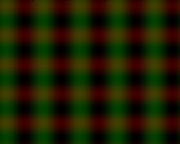
Monocular rivalry
Encyclopedia

Visual perception
Visual perception is the ability to interpret information and surroundings from the effects of visible light reaching the eye. The resulting perception is also known as eyesight, sight, or vision...
that occurs when two different images are optically superimposed. During prolonged viewing, one image becomes clearer than the other for a few moments, then the other image becomes clearer than the first for a few moments. These alternations in clarity continue at random for as long as one looks. Occasionally one image will become exclusively visible and the other image invisible.
In the demonstration, one image is a green grating
Grating
A grating is any regularly spaced collection of essentially identical, parallel, elongated elements. Gratings usually consist of a single set of elongated elements, but can consist of two sets, in which case the second set is usually perpendicular to the first...
and the other is a red grating. During prolonged inspection, the viewer can see the green grating as clearer than the red grating for a few moments, then the reverse. Occasionally the green grating will be all that is visible and occasionally the red grating will be all that is visible. Occasionally, at transitions, one will briefly see irregular composites of the two gratings (such as the red and green gratings superimposed but with one or two bars of the green grating invisible).
History of monocular rivalry
Monocular rivalry was discovered, and named, by Breese (1899). He called it monocular rivalry to distinguish it from binocular rivalryBinocular rivalry
Binocular rivalry is a phenomenon of visual perception in which perception alternates between different images presented to each eye.When one image is presented to one eye and a very different image is presented to the other, instead of the two images being seen superimposed, one image is seen for...
, a similar phenomenon in which the different images are presented to opposite eyes. Monocular rivalry was rediscovered by Campbell and Howell (1972). They called the phenomenon monocular pattern alternation, but Campbell called it monocular rivalry in later papers, and that is the term that has stuck, even though the phenomenon does not require monocular viewing. Maier, Logothetis, and Leopold (2005) have started calling the phenomenon pattern rivalry.
After a burst of research activity in the 1970s, monocular rivalry fell out of favour when Georgeson and Phillips (1980) argued that monocular rivalry arises from afterimage
Afterimage
An afterimage or ghost image or image burn-in is an optical illusion that refers to an image continuing to appear in one's vision after the exposure to the original image has ceased...
s and eye movements. They argued that with gratings, prolonged fixation of the stimuli builds up a negative afterimage that will tend to cancel the real images, making both invisible (a form of neural adaptation
Neural adaptation
Neural adaptation or sensory adaptation is a change over time in the responsiveness of the sensory system to a constant stimulus. It is usually experienced as a change in the stimulus. For example, if one rests one's hand on a table, one immediately feels the table's surface on one's skin. Within a...
). An eye movement at right angles to one grating of one half of the period
Periodic function
In mathematics, a periodic function is a function that repeats its values in regular intervals or periods. The most important examples are the trigonometric functions, which repeat over intervals of length 2π radians. Periodic functions are used throughout science to describe oscillations,...
of the grating will make the afterimage reinforce that original image, making it spring into visibility while the other grating remains invisible. A correct eye movement at right angles to the second grating will make it visible and leave the first invisible. Random eye movements, therefore, could be responsible for the random fluctuations in clarity and visibility of the two images.
Although afterimages and eye movements must contribute to monocular rivalry, they cannot be a complete explanation for at least four reasons: First, it occurs with stimuli other than gratings for which afterimages would not cancel or reinforce the original images (e.g., Sindermann & Lüddeke, 1972). Second, it occurs when the stimuli themselves are afterimages; these cannot be cancelled or reinforced by eye movements (Crassini & Broerse, 1982). Third, sometimes a perceptual alternation occurs after an eye movement in the wrong direction for Georgeson and Phillips's explanation (Bradley & Schor, 1988). Fourth, visibility of an irregular composite of the two images cannot be explained by eye movements. To be explained by cancellation of afterimages, such composites impossibly require that different parts of the retina move in different directions.
In 1997, Andrews and Purves revived interest in monocular rivalry by showing that its alternations could be entrained by binocular rivalry alternations in an adjacent part of the visual field.
Explanations of monocular rivalry
Breese attributed monocular rivalry to the same mechanism as responsible for binocular rivalry. Leopold, and Logothetis (1999) argued that it, and binocular rivalry, are examples of multistable perceptionMultistable perception
Multistable perceptual phenomena are a form of perceptual phenomena in which there are unpredictable sequences of spontaneous subjective changes...
phenomena, including the Necker cube
Necker cube
The Necker Cube is an optical illusion first published as a rhomboid in 1832 by Swiss crystallographer Louis Albert Necker.-Ambiguity:The Necker Cube is an ambiguous line drawing....
and Rubin vase
Rubin vase
Rubin's vase is a famous set of ambiguous or bi-stable two-dimensional forms developed around 1915 by the Danish psychologist Edgar Rubin...
figure.

